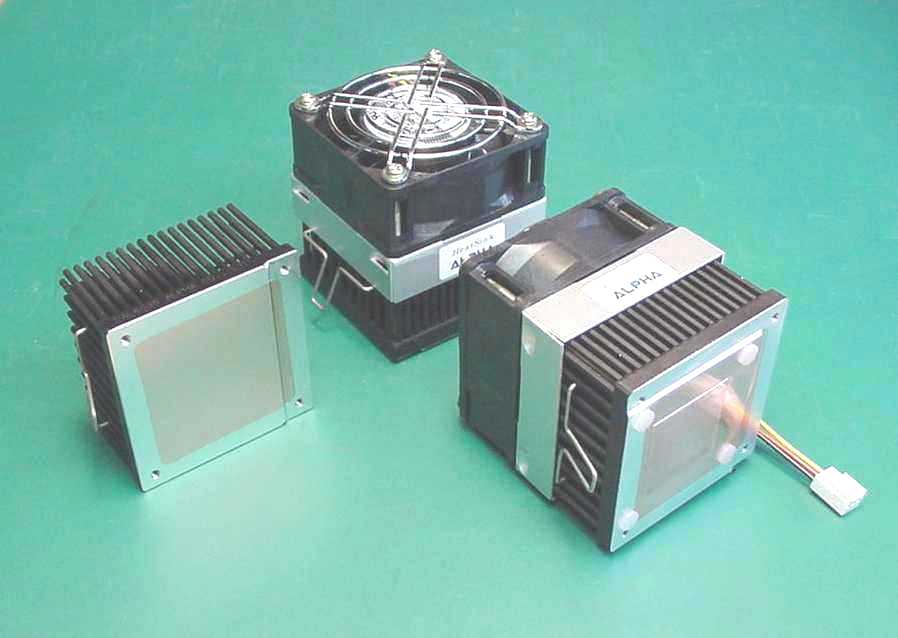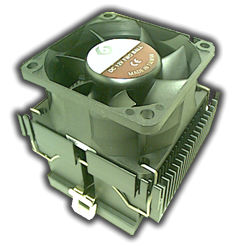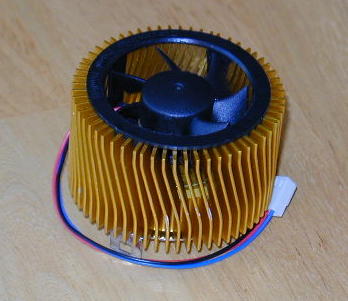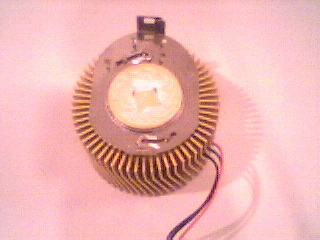


FC-PGA Heat Sink Comparison
The Competitors
| Generic CyberCooler | Alpha FC-PAL 35 | Global FOP 32 | Golden Orb |
|
|
|
The Alpha, Global, and Orb were all purchased from ![]()
The Test Conditions
Prior to testing the system was run for several hours so it was up to temperature before the first test. After installing each unit I let the system run Prime95 for 5 minutes then took readings during the 6th minute looking for the low, high, and average. This may seem like a very short time but I feel it was appropriate because:
a) With its small die size the Celeron II changes temperature very rapidly.
b) Tests run over very long periods of time introduce other factors, like variation in room temperature, and sunlight exposure
c) I have better things to do with my time than spending hours and hours testing heat sinks
After my first test run under normal conditions I re-tested with my usual extra ATX fan in place over the CPU. The fan is mounted in a piece of clear plastic purchased from Tap Plastics for 75 cents.
The Surprising Results
| Heatsink | Standard Test | Test with Extra Fan | |||||||
| High | Low | Average | RPM | High | Low | Average | RPM | ||
| Generic | $8 | 53 | 48 | 50.5 | 4100 | 52 | 46 | 49 | 4300 |
| Alpha PAL35 | $28 | 41 | 37 | 39 | 4963 | 38 | 35 | 36.6 | 4963 |
| Global FOP32 | $20 | 37 | 33 | 35 | 4115 | 37 | 32 | 34.5 | 4326 |
| Golden Orb | $14 | 37 | 33 | 35 | 4560 | 36 | 32 | 34 | 4753 |
Well, since the Alpha was tested just after the generic the performance seemed pretty good until I tested the Global and the Orb. At that point I was asking myself what gives? The Alpha is supposed to be number 1. So, I re-tested the Alpha and got identical results to the first test. Well my results just weren't making any sense at all until a close inspections of the heat sinks, after which I saw why the Alpha was getting out performed. Can you see the reason?
Generic Alpha
Global Orb

If you look closely you will notice how well defined the chip pattern is in the grease on all the heat sinks except the Alpha. This pattern is formed when the grease is compressed after installation. For some reason the Alpha had not seated as tightly as the others. So, I decided to test again, I applied a thin layer of grease, and this time I really smashed the Alpha down on the CPU.
Alpha after second try
The Design Flaw
Well as you can see even after very deliberately and forcefully smashing the sink onto the chip the results were the same. The Alpha was not seating correctly on my CPU. At this point I decided to pay a little more attention to the little plastic feet on the Alpha. These feet are supposed to make chip sit more stably on a FC-PGA CPU. However, I was beginning to suspect they were inhibiting the CPU from seating properly. So, out came the sand paper. I laid the paper out on a flat surface and carefully moved the heatsink back and forth across it until about 1/16 of an inch was sanded off the plastic feet. Then I re-tested.
| Heatsink | STD Test | Test with Extra Fan | ||||
| High | Low | Average | High | Low | Average | |
| Alpha PAL35 | 34 | 32 | 33 | 32 | 29 | 30.5 |
As you can see this is more in line with what we would expect from an Alpha. I was fortunate that I was testing the Alpha against other good coolers, and could see that my initial results were out of line. I wonder how many people buy this cooler install it, and never realize they are losing 5-6 degrees due to poor contact with the chip.
Performance Gains
With my generic cooler I was able to run my Celeron 566 at 850MHz at about 50 degrees. With all 3 of the high quality coolers my temperature was sufficiently reduced to run at 875MHz.
Other observations
Even though all the quality units were much larger and heavier than the generic, all the units tested fit easily with no clearance problems on my CUBX . The spring on the Global is so strong it left a 1/4 indentation in my thumb after attempting to fasten the clip. I finally reluctantly forced it into place with the tip of a large flat tip screw driver (you definitely don't want to slip doing this!). Study the locking mechanism on the Orb and make sure you understand it before you attempt to install it. You will want to watch carefully, and proceed cautiously, as many people have broken their socket with this cooler. The first time is the scariest, but after that you get the hang of it. When I ran my test with the extra fan I reversed the fan on the Alpha so that it would blow the same direction as the ATX fan. The extra air flow caused the fans to spin approximately 200 RPM faster on all of the coolers except the Alpha. Why the Alpha was unaffected is a mystery.
Conclusion
The best bang for the buck is definitely the Golden Orb. If you must have the best, then you will want the Alpha, but be prepared to do a little sanding.
Dave
[_private/navbar.htm]